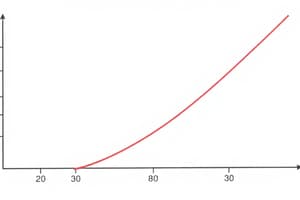Podcast
Questions and Answers
What happens to the marginal rate of substitution as a consumer increases the quantity of good X?
What happens to the marginal rate of substitution as a consumer increases the quantity of good X?
- It decreases. (correct)
- It increases.
- It remains constant.
- It becomes zero.
What is the shape of an indifference curve?
What is the shape of an indifference curve?
- Convex to the origin. (correct)
- Concave.
- Circular.
- Linear.
What happens when the indifference curve touches the X-axis?
What happens when the indifference curve touches the X-axis?
- The consumer has a finite quantity of both goods.
- The consumer has OM quantity of good X and none of good Y. (correct)
- The consumer has zero quantity of good X.
- The consumer has OL quantity of good Y and none of good X.
Which of the following statements about indifference curves is true?
Which of the following statements about indifference curves is true?
If the Marginal Rate of Substitution (MRS) is constant, what shape will the indifference curve take?
If the Marginal Rate of Substitution (MRS) is constant, what shape will the indifference curve take?
What does an indifference curve represent?
What does an indifference curve represent?
What characterizes the indifference curve of perfect complementary goods?
What characterizes the indifference curve of perfect complementary goods?
What indicates that a consumer is experiencing diminishing marginal rate of substitution?
What indicates that a consumer is experiencing diminishing marginal rate of substitution?
What occurs on an indifference curve for goods that provide zero satisfaction?
What occurs on an indifference curve for goods that provide zero satisfaction?
Which of the following best describes the slope of an indifference curve?
Which of the following best describes the slope of an indifference curve?
When the consumption of a product results in negative utility, how does its indifference curve appear?
When the consumption of a product results in negative utility, how does its indifference curve appear?
If the quantity of good X is increased while the quantity of good Y remains unchanged, what is the likely outcome?
If the quantity of good X is increased while the quantity of good Y remains unchanged, what is the likely outcome?
What is a characteristic of ordinary complementary goods?
What is a characteristic of ordinary complementary goods?
What does it mean if an indifference curve cannot touch either axis?
What does it mean if an indifference curve cannot touch either axis?
What happens when the MRS of X for Y increases?
What happens when the MRS of X for Y increases?
Which option best describes the situation when a consumer has its minimum quantity of a perfect complementary good?
Which option best describes the situation when a consumer has its minimum quantity of a perfect complementary good?
What is the significance of the marginal rate of substitution (MRS)?
What is the significance of the marginal rate of substitution (MRS)?
If the indifference curve shifts to the right, what does it imply about the consumer's satisfaction level?
If the indifference curve shifts to the right, what does it imply about the consumer's satisfaction level?
Which of the following best describes transitivity in consumer preferences?
Which of the following best describes transitivity in consumer preferences?
In the provided indifference schedule, what is the marginal rate of substitution when moving from combination M to N?
In the provided indifference schedule, what is the marginal rate of substitution when moving from combination M to N?
According to indifference curve analysis, which of the following concepts describes the group of multiple indifference curves?
According to indifference curve analysis, which of the following concepts describes the group of multiple indifference curves?
How does the indifference analysis approach measure utility?
How does the indifference analysis approach measure utility?
What does the combination L represent in the indifference schedule?
What does the combination L represent in the indifference schedule?
What does a budget line represent?
What does a budget line represent?
Which of the following features is characteristic of a budget line?
Which of the following features is characteristic of a budget line?
What is the meaning of consumer’s equilibrium in the context of a budget line?
What is the meaning of consumer’s equilibrium in the context of a budget line?
What does MRSxy represent in consumer equilibrium?
What does MRSxy represent in consumer equilibrium?
At what point is the consumer considered to be in equilibrium?
At what point is the consumer considered to be in equilibrium?
Which of the following combinations represents a point on the budget line for a consumer with Rs. 50 income?
Which of the following combinations represents a point on the budget line for a consumer with Rs. 50 income?
What is indicated by the negative slope of a budget line?
What is indicated by the negative slope of a budget line?
Which condition must be fulfilled for consumer equilibrium in relation to price ratios?
Which condition must be fulfilled for consumer equilibrium in relation to price ratios?
Flashcards
Indifference Curve
Indifference Curve
A curve showing all combinations of two goods that yield the same level of satisfaction to a consumer.
Indifference Map
Indifference Map
A group of indifference curves, each representing a different level of satisfaction.
Indifference Schedule
Indifference Schedule
A table listing combinations of two goods that provide equal levels of satisfaction.
Marginal Rate of Substitution (MRS)
Marginal Rate of Substitution (MRS)
Signup and view all the flashcards
Consumer Transitivity
Consumer Transitivity
Signup and view all the flashcards
Utility (in this context)
Utility (in this context)
Signup and view all the flashcards
Ordinal Measurement of Utility
Ordinal Measurement of Utility
Signup and view all the flashcards
MRSxy (Marginal Rate of Substitution of X for Y)
MRSxy (Marginal Rate of Substitution of X for Y)
Signup and view all the flashcards
Diminishing Marginal Rate of Substitution (MRS)
Diminishing Marginal Rate of Substitution (MRS)
Signup and view all the flashcards
Slope of Indifference Curve
Slope of Indifference Curve
Signup and view all the flashcards
Negative Slope of Indifference Curve
Negative Slope of Indifference Curve
Signup and view all the flashcards
Higher Indifference Curve = Higher Satisfaction
Higher Indifference Curve = Higher Satisfaction
Signup and view all the flashcards
Indifference Curves Don't Intersect
Indifference Curves Don't Intersect
Signup and view all the flashcards
Convex Shape of Indifference Curve
Convex Shape of Indifference Curve
Signup and view all the flashcards
Indifference Curve Cannot Touch Axes
Indifference Curve Cannot Touch Axes
Signup and view all the flashcards
Transitivity Assumption
Transitivity Assumption
Signup and view all the flashcards
Indifference Curve touching Axis
Indifference Curve touching Axis
Signup and view all the flashcards
Reason for Non-Parallel Indifference Curves
Reason for Non-Parallel Indifference Curves
Signup and view all the flashcards
Exception 1: Constant MRS and Straight Indifference Curve
Exception 1: Constant MRS and Straight Indifference Curve
Signup and view all the flashcards
Exception 2: L-Shaped Indifference Curve - Perfect Complements
Exception 2: L-Shaped Indifference Curve - Perfect Complements
Signup and view all the flashcards
Exception 3: Horizontal Indifference Curve
Exception 3: Horizontal Indifference Curve
Signup and view all the flashcards
Exception 4: U-Shaped Indifference Curve
Exception 4: U-Shaped Indifference Curve
Signup and view all the flashcards
Budget Line
Budget Line
Signup and view all the flashcards
Slope of the Budget Line
Slope of the Budget Line
Signup and view all the flashcards
Consumer Equilibrium
Consumer Equilibrium
Signup and view all the flashcards
Conditions for Consumer Equilibrium
Conditions for Consumer Equilibrium
Signup and view all the flashcards
Why does the Budget Line have a negative slope?
Why does the Budget Line have a negative slope?
Signup and view all the flashcards
What does the budget line represent?
What does the budget line represent?
Signup and view all the flashcards
What happens to the Budget Line if income increases?
What happens to the Budget Line if income increases?
Signup and view all the flashcards
What happens to the Budget Line if the price of one good increases?
What happens to the Budget Line if the price of one good increases?
Signup and view all the flashcards
Study Notes
Indifference Curve Analysis
- Indifference curve analysis is a new geometrical way to analyze consumer behavior.
- This approach was proposed by Hicks & Allen.
- It measures utility ordinally.
- It explains consumer behavior in terms of preferences or rankings for different combinations of two goods (e.g., X and Y).
- An indifference curve is drawn from the indifferent schedule of the consumer.
Indifference Schedule
- An indifference schedule is a list of combinations of two commodities that yield equal satisfaction.
- Example schedule provided in the document shows combinations of Goods X and Y.
Indifference Curve
- An indifference curve is a diagrammatic representation of an indifference schedule.
- It's a line showing all possible combinations of two goods between which a person is indifferent.
- Graph of indifference curve provided in document shows various combinations of Goods X and Y.
Indifference Map
- An indifference map is a group of indifference curves representing different levels of satisfaction.
- Higher indifference curves represent a higher level of satisfaction.
- The indifference curves shift to the right as the level of satisfaction increases.
- "I1<I2<I3" indicates increasing levels of satisfaction.
Assumptions of Indifference Curve
- Consumers act rationally to maximize satisfaction.
- There are two or more goods (e.g., X and Y).
- Utility is measured ordinally.
- Consumers are consistent in their choices.
- Consumer preferences exhibit transitivity.
Marginal Rate of Substitution (MRS)
- MRS is the rate of exchange between some units of goods X and Y.
- It reveals the rate at which a consumer is willing to give up one good to obtain another while maintaining the same level of satisfaction.
- The MRSxy value shows the amounts of Y sacrificed to gain one more X.
- MRS diminishes as more X is acquired.
Properties of Indifference Curve
- Indifference curves have a negative slope.
- Higher indifference curves represent higher levels of satisfaction.
- Indifference curves do not intersect.
- Indifference curves are convex to the origin due to diminishing marginal rate of substitution.
Exceptions to Indifference Curves
- Exception 1: If MRS of X for Y or Y for X is constant, the indifference curve is a straight line sloping at a 45° angle.
- Exception 2: Perfect complementary goods have L-shaped indifference curves (e.g., left and right shoes).
- Exception 3: Horizontal indifference curves indicate a good yielding zero satisfaction to a consumer.
- Exception 4: U-shaped indifference curves occur for goods with negative utility beyond a certain quantity.
Budget Line
- A budget line shows all combinations of two goods that a consumer can afford with a given income and prices.
- It's also known as a price line, consumption possibility line, or line of attainable combinations.
- Example of budget line calculation with income is provided.
Features of Budget Line
- Budget lines have a negative slope.
- Budget lines are straight lines.
- Budget lines represent real income and spending amounts.
- Budget lines are tangent to indifference curves at equilibrium points.
Consumer's Equilibrium
- Consumer equilibrium is achieved when the consumer maximizes utility with given income and market prices.
- Two conditions must be met for equilibrium:
- MRSxy = MUx/MUY = Px/Py
- Indifference curves are convex to the origin.
Graphical Presentation
- The equilibrium point (tangency) of the budget line and highest attainable indifference curve represents consumer equilibrium.
Studying That Suits You
Use AI to generate personalized quizzes and flashcards to suit your learning preferences.




